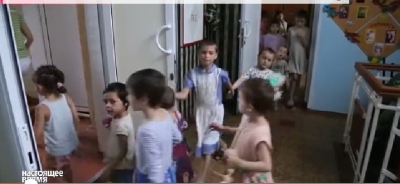Children of Donbas: adopted, abandoned, used for propaganda
 From the Radio Svoboda video
From the Radio Svoboda video
According to the Ministry of Social Policy 345 children from the Donbas and Luhansk oblasts have been adopted since 2014, this reflecting an increase which is undoubtedly due to the military conflict A number of children’s homes were finally evacuated last year from areas under the control of Kremlin-backed militants, however all are full again of children whose parents for one reason or another are unable to look after them.
Earlier in June UNICEF warned that children were in danger following the renewed violence in eastern Ukraine. They have been suffering terribly since the beginning of the fighting or what is termed the anti-terrorist operation [ATO]. UNICEF says that at least 68 children have been killed, though it believes the actual number to be much higher.
On June 12 2014, militants from the self-proclaimed ‘Donetsk People’s Republic’ seized a bus taking 16 children from a Snizhne orphanage to safety in the Dnipropetrovsk region, and took them, together with two accompanying adults, into Russia. There was outcry and the children were brought home, however in July 2014 an attempt was made to take 40 infants, 18 under a year old, to Russia. On that occasion, Russian officials positively obstructed efforts to prevent the abduction.
Try Googling “Children of Donbas” and you’ll find multiple entries about the allegedly heinous Ukrainian regime and heroic militants and welcome and medical treatment received in Russia. The supposed concern was not evident when over the summer months last year during fierce fighting the militants refused to allow the evacuation of children in need of medical care. There were 135 such children, for example, from the Donetsk and Donetsk regional children’s homes (41 and 48 children, respectively) as well as 46 children with HIV from the Malyatko Children’s Home in Makiyivka.
Most of the children’s homes in Donbas were finally evacuated to safe areas in Ukraine away from the fighting, however Ruslan Kolbasa from the Ministry of Social Policy reports that 15 family-type children’s homes from Crimea and Donbas have been taken to Russia.
As mentioned, the evacuated children’s homes did not remain empty for long, with many if not all of the children now living there ‘social orphans’ with parents unable or unwilling to take care of them.
Radio Svoboda heard two quite different points of view about whether and how these children can be helped, when assistance is very clearly needed. Aksana Filipishyna, head of the Ombudsperson’s Department on the Rights of the Child, points out that while the government has seemingly fulfilled its duty and evacuated the children, the new children needing care in areas not under government control are forgotten about.
She has no idea and says that probably nobody knows how many such children there are since it’s difficult to have contact with the children’s homes, but she thinks there are a lot. She cites for example the children’s home in Makiyivka from which all the children were evacuated last year. There are now 40 children there, 11 of whom are HIV-positive.
Filipishyna is convinced that a system could be drawn up, with the involvement of international organizations, the Red Cross or UNICEF, for example, in order to enable assistance for such institutions on a regular ongoing basis.
The President’s Representative on Children’s Rights, Mykola Kuleba is sceptical. He says that there would need to be some degree of agreement with those in control in the militant-controlled area for any systematic help for the children’s homes to be implemented, and this, he asserts, is impossible. “All that we can do is to work through volunteers. We also seek assistance from other countries to help these children. However there can’t be any official links since Ukraine cannot hold any negotiations with terrorist groups”.
This probably reflects the general position taken at present by the President’s Administration and at least some members of parliament which are calling for a total blockade of areas under Kremlin-backed militant control.
How much assistance is directly provided by the state is probably debatable, but there are cheering initiatives.
In May people from Hlobyno and surrounding districts (Poltava oblast) collected two and a half tonnes of humanitarian aid for the children’s home in Khartsyzk. The truck carried badly needed potatoes, preserves, and other foodstuffs, as well as children’s clothing, books, toys and items of personal hygiene.
While staple foods – macaroni, grain - are available in the children’s homes, there aren’t enough fruit and vegetables, fish or meat, the staff explain. And the supplies that they do get, from volunteers, are irregular.
They explain that the only possibility for the children is adoption, but tragically, whereas a relative lull in the fighting has meant that adoption processes have resumed in areas under Ukrainian control, the chances in areas under militant control appear to be nil.





